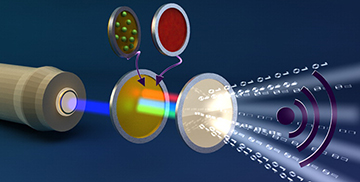
A KAUST team has proposed a setup that embeds perovskite nanocrystals, combined with conventional red phosphors, into a thin film. The film converts the blue beam from a laser diode into red, green, and blue channels that can combine to form well-balanced white illumination—and that can be modulated fast enough to carry wireless data at 2-Gbit/s rates. [Image: I. Dursun et al., ACS Photon., doi: 10.1021/acsphotonics.6b00187][Enlarge image]
The promise of “Li-Fi,” or visible-light communications (VLC), in which ambient indoor LED lighting does double duty as a wireless data communication channel, has repeatedly been raised as part of the future solution to the public’s seemingly insatiable appetite for bandwidth. But the phosphors used in conventional LED lighting don’t perform their color-conversion chores fast enough to support the data rates demanded by the modern internet.
Now, scientists in Saudi Arabia have developed a light converter using perovskite nanocrystals that they believe may boost VLC’s prospects (ACS Photon., doi: 10.1021/acsphotonics.6b00187). According to the team, the new phosphor could give LED lighting the ability to transmit data at rates of up to 2 Gbit/s—with a warm color balance that could prove competitive among finicky consumers of indoor lighting.
Solid-state lighting as a data channel
In principle, VLC is an attractive data channel for internet cafes, stores and other indoor settings. In such applications, having internet data hitch a ride on the visible-light waves coming from solid-state lamps offers some security advantages. And, in contrast to the crowded radio-frequency and microwave bands, the visible part of the spectrum is unregulated, eliminating the requirement to license spectrum from a government authority (see “Optical Wireless Communications,” OPN, March 2014).
In practice, though, in spite of some high-profile demonstrations, there have been a few technical hurdles to rolling out VLC in a big way. One of those relates to the way solid-state lighting is currently implemented. In a typical solid-state lamp, a share of light from a blue LED or laser diode strikes phosphors that convert the light to green and red, which mix together with the remaining blue light to form ambient white light.
The most common phosphor for white LEDs, yttrium aluminum garnet, has a long excited-state lifetime, on the order of microseconds. That, in turn, implies the ability to modulate the optical signal at a rate of only 3 to 12 MHz, limiting data transfer to the area of 100 Mbit/s—far too slow to meet today’s consumer expectations. While next-gen organic LEDs have improved on those numbers, their modulation bandwidths still fall short of what’s required to support the data rates demanded today.
The perovskite promise
To find a route to faster modulation for VLC, scientists at the King Abdullah University of Science & Technology (KAUST), Saudi Arabia, led by OSA Member Boon Ooi, turned to an up-and-coming family of optoelectronic materials, lead-halide perovskites. These materials have already captured significant attention as a potential foundation for low-cost solar cells, owing to their favorable charge transport and emission characteristics and low manufacturing costs (see “Perovskite Photovoltaics: Hitting Their Stride,” OPN, November 2014).
The KAUST group wanted to find out if those favorable properties could be pressed into service to create a more nimble light converter that could support the data rates needed for practical VLC. To do so, they synthesized nanocrystals of CsPbBr3 perovskite—which emits green light at a 512-nm wavelength when excited by blue light—and combined the nanocrystals with a conventional red-emitting nitride phosphor in a transparent film. The team then hit the film with a 450-nm blue beam from a GaN laser diode, and analyzed the light that came from the red-green-blue combination.
“Dual-function systems”
The scientists found that the perovskite-nanocrystal/phosphor combination produced white light with a high color rendering index of 89 and with a correlated color temperature of 3236 K—both highly advantageous values for indoor lighting. More important, the very short, 7-ns excited-state lifetime of the perovskite nanocrystals meant that the beam could support modulation bandwidths of some 491.4 MHz—an order of magnitude above conventional LEDs, and consistent with data transfer rates of up to 2 Gbit/s.
The team concludes that the rapid response times and favorable color characteristics (coupled with low manufacturing costs) could “pave the way for a new generation of dual-function systems” that bring both light and data to your laptop at the local coffee bar.
